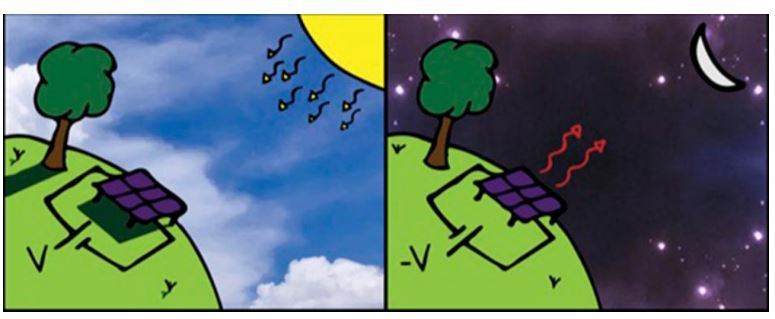The market for solar photovoltaics (PV) has expanded greatly in recent years. Solar energy is fast becoming the cheapest means of electricity production. Now researchers from the University of California have developed a new way to harness even more power.
Researchers have devised Anti-solar cells, a new type of photovoltaic cell that works at night. These could lead to the harnessing of substantially more renewable energy.
They have designed a photovoltaic cell that could generate up to 50 watts of power per square meter under ideal conditions at night. That is nearly equal to a quarter of what a conventional solar panel can generate in daytime.
Science Behind:
Anti-Solar cells work in a way similar to the way a normal solar cell work, but in reverse. Therefore these are referred to as “anti-solar panels”.
For this scientists used the earth as a heat source and the night sky as a heat sink.
Since Solar panels are cold in comparison to the Sun, they absorb the Sun’s light and turn it into energy. Similarly, Space is very cold. So if we point comparatively warm panels on Earth towards it, it will radiate heat as invisible infrared light. Capturing this power, electricity can be generated.
Jeremy Munday, a professor in the Department of Electrical and Computer Engineering, said, “You have heat energy coming from the Sun towards the Earth and that normal solar cell picks off that energy as it’s transmitted from the Sun to the Earth, so basically you need these two different temperature bodies and some way of converting that power,”
“What this nighttime device does is a similar sort of thing—where it’s just taking a hot body and a cold body—but now the relatively hot body is the Earth and space is the cold body. As this heat is flowing from the Earth to outer space, it’s picking that off and converting that into power.”
Featured Image: A conventional photovoltaic or solar cell, left, absorbs photons of light from the sun and generates an electrical current. A thermoradiative cell, right, generates electrical current as it radiates infrared light (heat) toward the extreme cold of deep space. UC Davis engineers propose that such cells could generate a significant amount of energy and help balance the power grid over the day-night cycle. TRISTAN DEPPE/JEREMY MUNDAY-COURTESY






